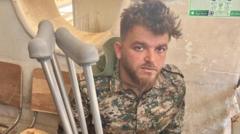In the battle-scarred Suweida province of southern Syria, a fragile ceasefire appears to be holding despite a week of intense sectarian violence between Druze fighters and Bedouin tribal militia. The clashes have left over 1,000 people dead, sparking a humanitarian crisis as the community grapples with the aftermath of war.
The BBC has cautiously approached the region, managing to get within six miles of Suweida city. However, the area is deemed perilous, as Druze snipers remain a significant threat, forcing reporters to keep a safe distance. Along the way, evidence of violence is stark: deserted Druze villages are now under Syrian government control, and the highway leading to the city is littered with remnants of battle, including shell casings and ruined businesses.
Four days have elapsed since the Syrian government deployed troops to enforce the ceasefire, a move aimed at quelling tensions following the brutal clashes. Yet, reports suggest the ceasefire remains unstable, as armed Bedouin fighters are reportedly prepared to re-engage if their demands are not met, particularly regarding the release of injured fighters detained in the city.
As our coverage continued southward, we encountered groups of Bedouin fighters, visibly agitated and sending warning shots into the air. Leaders from this faction expressed readiness to resume fighting if the ceasefire collapses, indicating a deep-rooted distrust between the communities. They allege that Syrian government forces have engaged in summary executions and have shown favoritism towards the Bedouin militias.
Medical evacuations have been attempted by the Syrian Red Crescent; however, understaffed hospitals are struggling to cope with those wounded in the violence. Coordination efforts are hampered by the ongoing threat of sniper fire, further complicating the dire humanitarian situation. One soldier we spoke to shared harrowing accounts of the violence, revealing the gruesome aftermath of the recent clashes while raising concerns about safety and access to medical care.
In a recent statement, a local disaster management minister emphasized a collective need for unity in overcoming the challenges facing Syria. Yet, as we observed the devastation on the ground, optimism and hope seemed overshadowed by the apparent despair and fear experienced by residents, pushing the future towards an uncertain horizon. Local leaders call for inter-community cooperation amid the chaos, reflecting a desire for peace, yet skepticism remains pervasive as tensions simmer just beneath the surface in this volatile region.
The BBC has cautiously approached the region, managing to get within six miles of Suweida city. However, the area is deemed perilous, as Druze snipers remain a significant threat, forcing reporters to keep a safe distance. Along the way, evidence of violence is stark: deserted Druze villages are now under Syrian government control, and the highway leading to the city is littered with remnants of battle, including shell casings and ruined businesses.
Four days have elapsed since the Syrian government deployed troops to enforce the ceasefire, a move aimed at quelling tensions following the brutal clashes. Yet, reports suggest the ceasefire remains unstable, as armed Bedouin fighters are reportedly prepared to re-engage if their demands are not met, particularly regarding the release of injured fighters detained in the city.
As our coverage continued southward, we encountered groups of Bedouin fighters, visibly agitated and sending warning shots into the air. Leaders from this faction expressed readiness to resume fighting if the ceasefire collapses, indicating a deep-rooted distrust between the communities. They allege that Syrian government forces have engaged in summary executions and have shown favoritism towards the Bedouin militias.
Medical evacuations have been attempted by the Syrian Red Crescent; however, understaffed hospitals are struggling to cope with those wounded in the violence. Coordination efforts are hampered by the ongoing threat of sniper fire, further complicating the dire humanitarian situation. One soldier we spoke to shared harrowing accounts of the violence, revealing the gruesome aftermath of the recent clashes while raising concerns about safety and access to medical care.
In a recent statement, a local disaster management minister emphasized a collective need for unity in overcoming the challenges facing Syria. Yet, as we observed the devastation on the ground, optimism and hope seemed overshadowed by the apparent despair and fear experienced by residents, pushing the future towards an uncertain horizon. Local leaders call for inter-community cooperation amid the chaos, reflecting a desire for peace, yet skepticism remains pervasive as tensions simmer just beneath the surface in this volatile region.


















